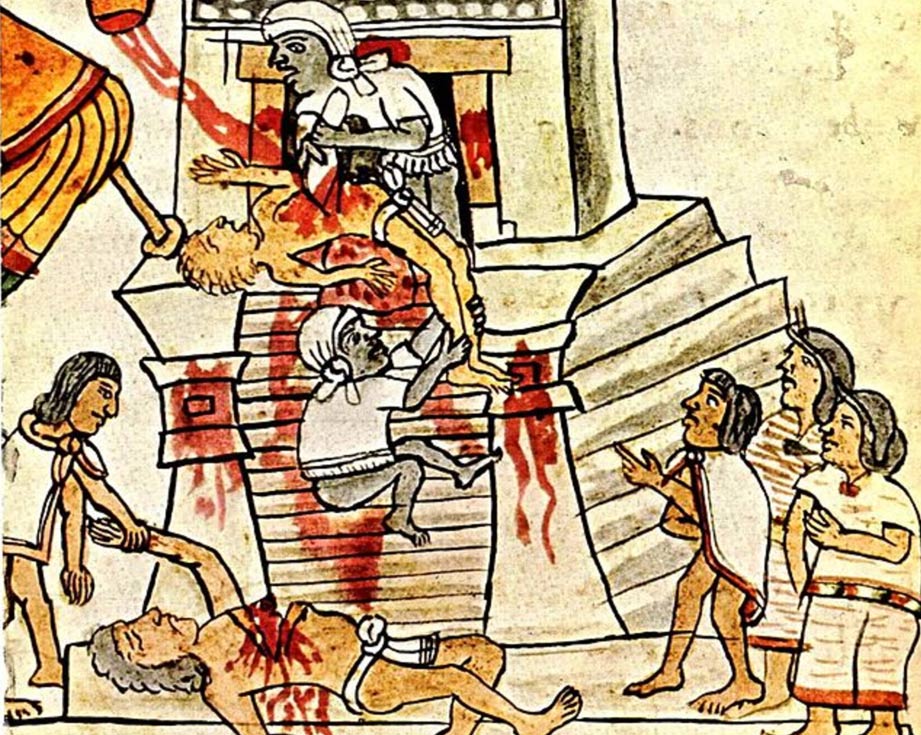Today, in the twenty-first century I have seen many, many Aztec dances as performed by different folklorico groups[1]. Usually, when we perform the Aztec dances they are depicted as very solemn and part of a ritual ceremony. It is true that the Aztecs did dance as part of religious celebrations. They also danced war and victory dances. Yet, not all the Aztec dances were serious. Some of these dances were humorous and meant to entertain. The following is an excerpt from the book Dancing Throughout Mexico (1325-1910) as written by Sanjuanita Martínez-Hunter and edited by myself.
Gymnastic Feats as Part of Aztec Dance
Both conquerors and the Spanish nobility admired the gymnastic and acrobatic feats of the Aztecs. This type of dance was a graceful spectacle requiring strength and braveness. In his History of Mexico, Hubert Bancroft vividly describes a feat similar to the famous “Chinese foot-balancing trick in which the performers lying on his back, spins a heavy pole on the soles of his raised feet, throws it up, catches it, and twirls it in every direction (82).” Another athletic stunt is described by Bancroft:
A favorite feat was for three men, mounted one on the shoulders of another, and the third standing on the head of the second, to move slowly around the circle of spectators, while a kind of dance was performed by the man at the top of a beam, the lower end of which was forked, and rested on the shoulders of two other dancers…Some raised a stick from the ground, with a man balanced at the end of it; others leaped upon a stick set upright in the ground, or danced upon the tight-rope (82)
Humorous Dances
Humorous dances were included in the Aztec repertoire of recreational dances. In some, the dancers donned masks and wore humps like hunchbacks to provoke laughter from the audience. In others, buffoons would appear, mimicking the people of other tribes by making funny faces and engaging in verbal ridicule (Génin, 659). On festival days these burlesque spectacles were a favorite means of entertainment for the Aztecs after dinner. The deaf, lame, blind, sick, and deformed were ridiculed. Sometimes even prominent citizens and merchants were mimicked (Bancroft 82).
Imagining Aztec Dance as Humorous
Sitting here at my computer in the twenty first century, I can’t help but try to imagine what these dances must have looked like. Imagine Aztec dances filled with gymnastic tricks. Dances that mimicked the people of other tribes. Aztecs dressing up as prominent citizens to make fun of them. What fun! To think that this all happened after dinner. I wish I could have been a part of that! Do you?
Dancing Throughout Mexico (1325-1910)
The preceding is an excerpt from the book Dancing Throughout Mexico (1325-1910) as written by Sanjuanita Martínez-Hunter and edited by myself. This book traces the history of dance in Mexico from the Pre-Hispanic era to the year 1910. It includes historical accounts of Aztec dances, dance-dramas, sones and jarabes, ballroom dances and much more. The author Sanjuanita Martínez-Hunter was my aunt. She first wrote this work in 1984 as part of the requirements to complete her doctorate in Dance from Texas Woman’s University. She always wanted to publish this work but never had a chance. A little more than a year after her death, I have edited it for her. It will be available for sale on amazon within the coming months. Please be on the lookout for it.

[1] I use the term Aztec dance instead of concheros because I am writing about the ceremonial and social dances of the Aztec people
Photos courtesy of Gabriela Mendoza-Garcia. They are of the dancers of Roy Lozano’s Ballet Folklorico de Texas from the 1990s.
Copyright, 4/22/18, Mendoza-Garcia

Gabriela Mendoza-García Ph.D. is an Artist and Scholar. She has her own dance school and company called the Gabriela Mendoza-García Ballet Folklórico in Laredo, Texas. Dr. Mendoza-Garcia founded this group in 2013 and teaches children and adults of all ages. Her company consists of seasoned folklórico dancers with years of experience performing this art form. She teaches traditional Mexican folklórico dance pieces, as well as, works that are inspired by her scholarly research. Her scholarship includes: Dancing throughout Mexican History (1325-1910), History & Folklore booklet with an accompanying documentary sponsored by the Webb County Heritage Foundation, The Jarabe Tapatío: Imagining Race, Nation, Class and Gender in 1920s Mexico published by Oxford University Press, an on-line blog, writings for Asociación Nacional de Grupos Folklóricos, and others.



4 thoughts on “Was Aztec Dance Humorous?”